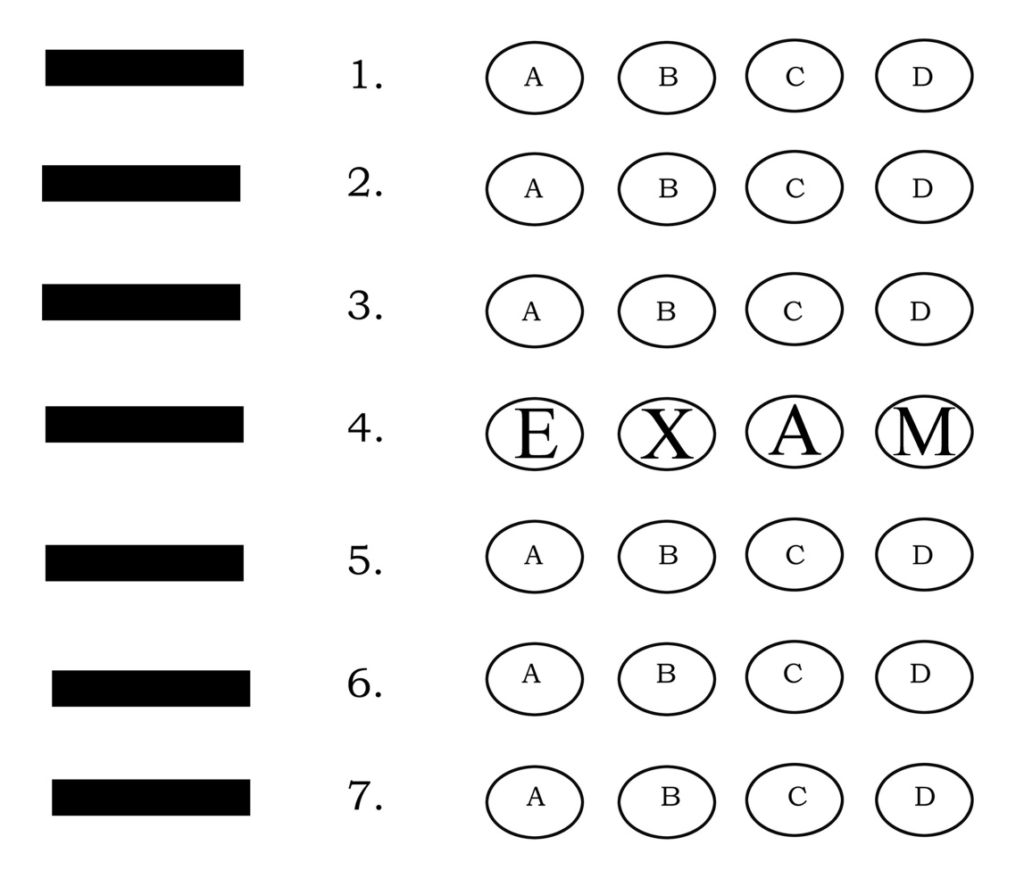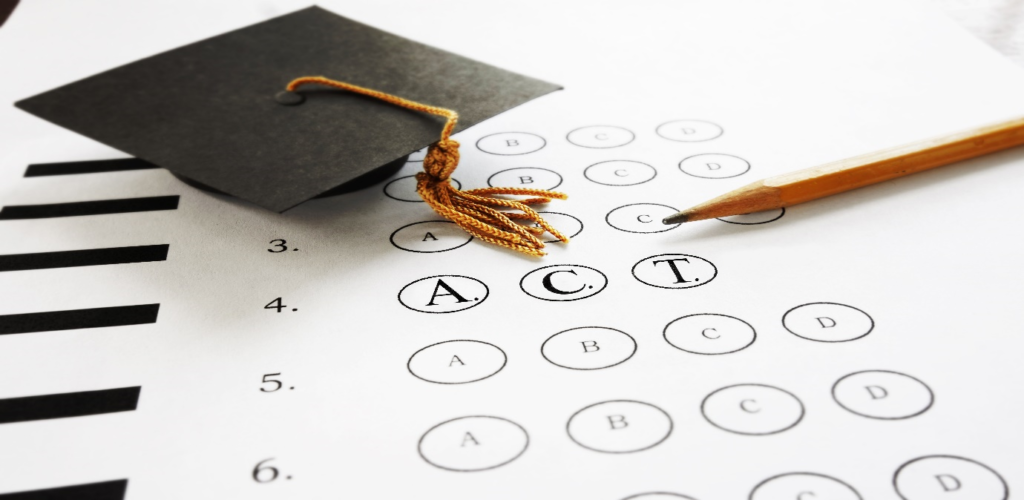The ACT Math section, like the other sections of the test, does not test what you know so much as it tests how well you can apply what you know. The actual math on the test is not easy, but it’s not as difficult as you probably imagine. For most questions, the primary challenge is figuring out what the question requires you to do. It can be helpful to break the process down into three distinct steps:
- Identify what you’re asked to find. Read the question carefully and underline the thing you’re asked to find.
- Scan the question-and-answer choices for patterns and shortcuts. Often, a quick scan will reveal something that enables you to work more efficiently.
- Solve the question in an organized way. The best way to avoid mistakes is to work methodically.
- How to overcome test anxiety: Test-takers who struggle on the ACT math portion generally do so because they lack a clear understanding of the three distinct steps to solving the question. That lack of clarity creates test anxiety, which drives test-takers to rush through steps 1 and 2 or, worse, to skip those steps entirely. It’s vital that you’re aware of the role that anxiety plays in driving some test-takers to abandon their training on test day. If you allow anxiety to determine your approach or set your pace, your score will be affected.
- How to develop good habits: As you begin prepping for the math portion, we strongly recommend that you commit to working slowly and deliberately through each step. As you do, pay close attention to the feeling you experience each time you approach a question. Notice whether you feel an urge to rush through steps 1 and 2 or to skip them entirely. It’s critical that you learn to recognize these impulses and remain calm instead of charging ahead without a plan. Be sure to develop these skills before you shift your attention to speeding up your pace.
- How to improve your pacing: Focusing on speed before you’ve developed good habits can make it more challenging to master the skills you need to become a more efficient test-taker. This is an important distinction: efficiency and speed are not the same thing. In ACT prep, improving efficiency increases test scores. Obsessing about speed increases anxiety and mistakes, both of which lower test scores. So, as you begin this section, commit to slowing down, focusing on steps 1 and 2, and remaining calm as you solve each question.
- How to optimize your score: Over time, as your efficiency improves, you will naturally pick up speed — and because that speed is the result of efficiency, it won’t come at the cost of increased mistakes. On the contrary, the number of mistakes you make will decline because you’ll know what to solve and how to avoid performing unnecessary work. Eventually, once identifying, scanning, and solving have become habits, you can turn your attention to optimizing your score by picking up speed on steps 1 and 2 without rushing to step 3 and committing errors.
- How your attitude can predict your score improvement: Especially in the math section, the biggest difference between students who improve and students who don’t is their attitudes. Students who fail to improve react to a wrong answer by getting frustrated or by dismissing the wrong answer as a “silly mistake.” In either case, the reaction prevents the opportunity to learn from that mistake. In contrast, students who improve their scores tend to react to wrong answers with an eagerness to discover their mistakes and figure out how to avoid making the same mistake in the future
Choose the Best Approach for You
If you’ve scored 30 or above (95th percentile) on a timed, authentic ACT practice test, then you may want to use Approach 2. That said, you should definitely read and consider Approach 1 before you make your decision. For everyone else (95% of all test-takers), you’ll want to use Approach 1. But before we get to that, you need to understand a few very important facts about question difficulty, trends in performance, and raw/scaled scores:
Question Difficulty
- The difficulty of ACT math questions increases throughout the section, from questions 1-60.
- Questions 1-20 are mostly easy with a few medium questions mixed in — especially near the end. • Questions 21-40 are mostly medium with a few easy questions mixed in near the beginning and a few harder questions mixed in after question 30.
- Questions 41-60 are most difficult with a few medium questions mixed in near the beginning.
- Questions 55-60 are all very difficult.
- There is rarely more than 1 hard question before 30 or 1 easy question after 30.
The good news for most students is that you don’t have to solve every question correctly. You don’t even need to attempt every question. In fact, you probably shouldn’t attempt every question. To be clear, you should never leave a question blank, but that doesn’t mean you have to waste time trying to solve a question that’s beyond your understanding. As you consider the following stats, keep in mind that random guessing has a one-in-five chance, which you’d expect to result in correct answers 20% of the time.
Trends in Student Performance
- Students scoring below 23 correctly answer < 50% of questions after #30 and < 30% after #40.
- Students scoring 23-29 correctly answer < 50% of questions after #50 and < 25% after #55.
- Students scoring above 30 correctly answer < 50% of questions after question #58.
As you can see, most students are actually better off skipping a significant number of ACT math questions. We recognize that some students won’t like the idea of planning ahead of time to guess on 5, 10, or even 20 questions, but the stats are clear. All students, even top-performing test-takers, hit a wall at some point during the ACT math section. The key is to identify where your “wall” shows up on the test, so you can plan ahead and make the best use of your time.
Sample Raw Scores Compared to Scaled Scores: The raw score (number of correct answers) required to earn a good score on the ACT Math section is not as high as you might expect. Again, this all points to the fact that most students shouldn’t plan to waste time on the most difficult problems on the test. Instead, that time should be put to better use by making sure you don’t commit any errors on the easier questions that you are more likely to be able to solve.
Approach 1: TAKE Your Time on Easy and Medium Questions
This approach is best for the vast majority of test-takers. The idea is to spend more time on the easy and medium questions, rather than wasting that time struggling to understand harder questions. For these students, there’s no point in rushing through the easy and medium-difficulty questions to get to the hard questions that they don’t know how to solve.
1. Review your initial diagnostic to identify where your score hits a “wall.”
The goal is to find the point after which you miss more than 50% of all the remaining questions. Sometimes, that’s obvious, but most of the time you’ll need to make a few basic calculations.
The easiest way to find your “wall” is to work backward from the end. Start by calculating the percentage correct for 60-51. Less than 50%? Try 60-41. Greater than 50% correct? That’s great! Try 60-45.
Let’s say you hit the wall after question 45. That’s not bad. If you can answer 40/45 before you hit the wall and then guess right on 3/15 (20%) of the remaining 15 questions, you’ll end up with 43 correct answers, which converts to a score of 27, putting you in the 88th percentile — and remember, that’s if you guess blindly on a quarter of the math section!
2. Calculate your optimal pacing strategy
In the above example, we recommend skipping the last 15 questions, which leaves you with an extra 15 minutes to spend however you want on the first 45 questions. If you allocate that time evenly among all 45 questions, you’ll have 1.25 minutes per question (+25%). However, if you maintain your original pace of 1 minute per question for the easy questions (1-20), then you can use all 15 minutes to solve the medium and hard questions (21-45). This plan gives you a whopping 1.6 minutes (+60%) per question for 21-45 — and all it cost you was 15 minutes of wasted time!
3. Execute your optimal pacing strategy
A pacing strategy only works when it is simple enough to follow without becoming a distraction. So, let’s keep it simple. Through the first 20 questions, make sure that the time elapsed (in minutes) stays below the question number you’re solving. If you keep that pace, you’ll complete question 20 with 25 questions and 40 minutes remaining. That’s a ratio of 5 to 8, meaning you need to solve 5 questions every 8 minutes. You could check the time after every fifth question, but we recommend checkpoints after question 30 (36-min) and question 40 (52-min). From there on, just work as quickly as you can, and be sure to save a few seconds to bubble in guesses for questions 46-60!
Approach 2: BANK Your Time for Difficult Questions
If you are already scoring above 30 on authentic, timed ACT math tests, then first of all, congratulations!
Now, let’s get to work. Once you’re above 30, the best approach to maximizing your score is basically the opposite of Approach 1. Instead of freeing up time for easy and medium questions, Approach 2 is all about getting to the difficult questions with as much time as possible remaining.
Unlike Approach 1, however, you can’t just skip a bunch of easy and medium questions to free up time for the hard ones. Instead, you must answer every easy and medium question as efficiently as possible in order to BANK your time for the harder questions near the end of the section. Note: you should be answering more than 90% of the first 40 questions correctly. If that’s not the case, you should consider using Approach 1 and/or reviewing the steps mentioned.
1. Review your initial diagnostic test results.
Follow the steps described in Approach 1 to find where you hit a wall. For most students scoring above 30, that point comes somewhere around question 55. The higher your initial score, the later the wall. Whatever the case, it may still be advantageous for you to skip/ignore the final 2 or 3 questions and apply that time to make sure you answer the rest of the questions from 51-60 correctly. That’s your decision to make with your tutor.
2. Efficiency is everything
Focusing on “speed” is the wrong approach. Any time that you save will most likely come at the cost of increased errors. Of course, that defeats the purpose of speeding up, since the only reason to go faster is to allow yourself more time to earn points on harder questions! If you focus on efficiency, however, you’ll ultimately increase your speed without making errors.
3. Execute your optimal pacing strategy
Top scores are won or lost early on the test when you’re banking time for those last 10 questions and before that when you’re deciding whether to attempt all 60 questions. Your objective is to develop a sense of exactly how quickly you are able to solve math questions without making errors.
Unlike Approach 1, there is no formula you can use to determine your maximum safe speed. During the test, you will need to be able to feel your pace as you go. You can still set a few checkpoints to make sure you don’t get too far ahead or behind, but you will still need to be able to feel your pace, so you can stay balanced between too speedy and too cautious. Ultimately, there’s no point to pushing yourself to ace the last 10 questions, if doing so causes you to commit mistakes on easy and medium questions.
With that in mind, pay careful attention to pacing as you complete your workbook lessons, quizzes, and practice tests, so you can get more comfortable working at your maximum safe speed.
Scanning the answer choices
Below, we explain what to look for as you scan question-and-answer choices. Learning to spot the patterns and shortcuts on this list can really improve your score. Let’s take a look!
- From A to E or F to K, the answer choices are arranged in ascending order (i.e., least to greatest)
You may have already known this, but you probably weren’t aware of all the ways this simple pattern can help you solve difficult questions more efficiently. For example, when you’re solving backward by plugging in the answer choices, you can work methodically to minimize the number of answer choices you have to test.
- Pay attention to differences and similarities among answer choices
Each of the answer choices will be different, obviously. That said, a number of them may be similar in important ways. In only 2-3 seconds, you may notice a pattern that shows you how to approach the problem more efficiently, saving you an entire minute. Equally important, you may notice that two or more answer choices are very similar. In this case, make a mental note to be very careful when you match your solution to the answer choices after solving the problem.
- Be sceptical of “eye-catching” answers that reuse numbers from the question
The test-makers know that some students will be attracted — consciously or subconsciously — to answer choices that feel related to the question. Because test-makers know that eye-catching answer choices appeal to lazy test-takers, these answer choices are often incorrect.
- Pay attention to how the answer choices relate to each other, especially:
Multiples or factors (e.g., 11, 22, 44, 110). For example, if you notice that all of the answers are multiples of 11, then that is a clue as to how you should approach the question. So if you end up with 19, that’s a signal that you had a bad approach (as opposed to a good approach and a miscalculation).Pairs of positive/negative numbers (g., 4 and –4 or 1/7 and –1/7). When you see answer choices that are identical except for their +/– sign, this is a warning that you’ll need to be careful with your signs and when multiplying by negatives.Pairs of “flipped” answer choices (e.g., 2/9 and 9/2 or m/n and n/m). Often, one of the flipped answer choices is correct and the other is there to catch test-takers who made an error. Furthermore, some percentage of test-takers incorrectly match their correct answer to the answer choices and bubble in the letter corresponding to the flipped version.Pairs of complementary angles (e.g., 20º and 70º), supplementary angles (e.g., 46º and 134º), or explementary angles (e.g., 330º and 30º). This often indicates that one of the two is the correct answer, while the other one is just there to trap students who solved for the wrong part of the figure.Pairs of percentages that add to 100% (e.g. 60% and 40%). These trap test-takers who forget what they’re supposed to find and solve for the discount percentage or the percentage of the original price represented by the new price. The same goes for non-percentage answer choices (e.g., discount, the new price, the new price + sales tax). - Answer choices that form a series (g., 15, 18, 21, 24). Consider a question that asks you to find the perimeter of a regular hexagon with a side length of 3. To find the answer, you would multiply 6 (the number of sides) by 3 (length of each side): 6 x 3 = 18. That’s what you would do. But the test-makers know that some students don’t know how many sides a hexagon has. They might end up with 15 or 21. Other students may choose to punch in 3+3+3+3+3+3 = 18. That method produces the correct answer, but it’s slower – and way more dangerous as you will see! That’s because every calculator keystroke represents another chance to make an error. The more keystrokes, the more chances to mess up the calculation. For example, some students will punch in the wrong number of 3+3s, ending up with 3+3+3+3+3 = 15 or 3+3+3+3+3+3+3 = 21. In either case, these test-takers will almost always find their wrong answers conveniently waiting for them.
Remember that the answer choices are organized from least to greatest. So, if the correct answer, 18, was choice A, then there is nowhere to put the trap answer 15. As a result, test-takers who mistakenly ended up with 15 would not find their answer, which means they’d get a second chance to solve the problem. Following the same reasoning, the correct answer is not likely to be choice E because that would knock the trap answer 21 off the list of answers, giving a second chance to all the test-takers who ended up with 21.
The takeaway is that when you see answers in a series, you should lean toward B, C, or D because they’re slightly more likely to be the correct answer. Obviously, you should solve the problem if you can, but if you’re stumped, choose B, C or D. Of course, that doesn’t mean that it will never be A or E, but if you have to guess, you should choose B, C, or D.
- Equations translated from a word problem: If you’re not already a pro at it, you should definitely learn to translate word problems into equations. While translating is the most reliable way to solve a word problem, you may find that it’s more efficient to methodically check how a single variable from the word problem shows up in each answer choice. This is especially helpful for eliminating wrong answers on word problems that deal with variable cost and fixed cost. In these cases, you can usually eliminate one or even two answers that mishandle the fixed cost. Any answer choice that multiplies the fixed cost by any other number is wrong.
- Don’t just retrace your footsteps If you do complete the section with time remaining, you should review your answers. Start with any answers you weren’t certain of or that you guessed between two remaining answer choices.
There are two ways to review an answer: retracing your steps or solving the problem a new way. Between the two, solving the problem again is much more likely to help you uncover an error, especially if you solve it using a different method. For example, if you solved a simultaneous equation problem using substitution the first time, you should use elimination on your second pass. Reaching the same answer a different way is more reliable than solving it the same way and possibly repeating the same error you made the first time.
- When you’re short on time If you only have a few minutes left, you need to make quick decisions about which problems are most likely the best use of your time. Remember that difficulty is not necessarily a measure of the time it takes to solve the problem. For example, an easy question may not be quick to solve and a difficult question may only require a very simple calculation once you figure out what you’re asked to find. Regardless of a question’s difficulty, you can generally assume that the more text in the question and the more complicated the answer choices, the more time-consuming that question will be to solve. So, if you’re down to the wire, scan the page and target the question with the least text and least complicated answer choices.



